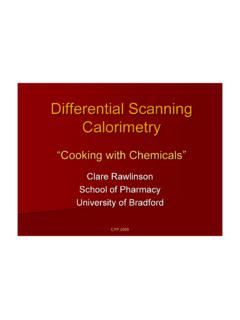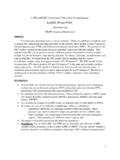Transcription of POLYPROPYLENE DEGRADATION AND DURABILITY …
1 POLYPROPYLENE DEGRADATION AND DURABILITY . ESTIMATES BASED ON THE MASTER CURVE CONCEPT. Lecon Woo, Michael Ling, Atul R. Khare, and Y. Samuel Ding Baxter International, Round Lake, IL 60073. INTRODUCTION. Material DEGRADATION and life prediction studies need to overcome numerous challenges. Among the most formidable is the long term real time data generation. The typical experimental time span seldom goes beyond a year, and various ways to accelerate the ageing process frequently encounter fundamental difficulties which reduces the value of the extrapolation or worse, totally negate it. F. Gugumus (1989) examined the oven stability of a POLYPROPYLENE film for up to about years between 40 and about 105 C, and the apparent activation energy in the Arrhenius plot was clearly variable with respect to temperature with a diminishing trend toward lower temperatures. Recently, when we examined a large amount of data over broad temperature ranges, including our own, for a variety of polymers, we also noted the general increasing trend of the apparent activation energy temperature.
2 This changing activation energy, or curvature in the Arrhenius plot, could be the major source of error in extrapolating from high temperature, short term data to near ambient long term life-time predictions. With this background, we began the search for experimentally demonstrable generalizations in selected polymer systems to guide further study. EXPERIMENTAL. A very stable (including manufacturing process, catalyst system and antioxidant package for over 20 years) medical grade POLYPROPYLENE random copolymer (PP1) with about 2 ethylene content and melt flow of about dg/min and stabilized with (2,4,6-tris-(3',5'-di-t-butyl-4'-hydroxy benzyl)1,3,5-trimethyl benzene ) and with about 100 ppm of calcium stearate as the acid scavenger was chosen as the primary system for study. A second sample, a radiation grade (totally different process and producer). random copolymer (PP2) with about ethylene and 25 melt flow and stabilized only with a hindered amine light stabilizer (HALS) with a phosphite synergist was also used in this study.
3 In addition, a black pigmented, highly stabilized construction grade homopolymer (PP3) with unknown antioxidant package was used for comparison. In addition, limited data were taken from a oriented POLYPROPYLENE film (OPP) with unknown antioxidants. Technique used in this study includes ASTM D3895-92 isothermal oxidative induction time (OIT) using a Dupont 1090 thermal analyzer with 910 differential scanning calorimetry (DSC) cell. Contrast to ASTM method which specifies a fixed temperature, we adopted a method similar to N. Billingham et al (1981) to cover a wide temperature range. High oxygen pressure OIT was conducted with a TA instruments high pressure DSC cell. Scanning Electron Microscopy (SEM) morphological analysis was conducted with a JEOL 6300 FESEM or a JEOL 35CF instrument after sputter coating with palladium for surface conductivity. Gamma exposure at various doses was conducted in a gamma cell at a dose rate of approximately 6 kGy/hr.
4 A more recent irradiation experiment was carried out with an electron beam irradiator with 10 MeV. energy at significantly higher dose rates. Typically, film samples between 150 and 250. microns in thickness were used unless specified otherwise. Digitally controlled forced convection air circulating ovens were used at various temperatures to assess long term oven stability with sample embrittlement as end points. RESULTS AND DISCUSSION. Catastrophic failures have been reported during the PP post irradiation shelf life storage period. Intense investigation has come to the following working model, that long lived free radicals trapped in the crystalline domains slowly migrate towards the crystalline /amorphous interface where they react with available oxygen to form peroxy and hydroperoxy radicals and initiate DEGRADATION near the interface as reported by Rolando (1993) and Woo et al.(1996) among others. When sufficient number of the tie molecules between crystallites were cut through this chain scission process, PP's elongation is reduced dramatically and catastrophic failures followed.
5 Since antioxidants in PP reside primarily in the amorphous phase, its effectiveness to react preferentially with primary free radicals governs the overall post irradiation stability. In an earlier study, PP2's OIT under air flow conditions of 100 ml/ min was determined and the result compared with the same film sample (about 130 micron in thickness) after 20 kGy of gamma dose. When the data was plotted in the Arrhenius form in Figure 1, it is clearly seen that the gamma exposure has significantly reduced the OIT. over the entire temperature range. In addition, the reduction factor appeared to be relatively constant, and the resulting approximately parallel curves hinted that a self- similarity may exist for this sample. To access still lower temperatures, where the OIT. detection becomes difficult, the gamma-exposed films were subjected to oven aging at 90 and 60 C and their failure times noted. When the oven failure times were plotted onto the Arrhenius plot with the gamma samples, a continuous curve emerged (Figure 2).
6 This continuity observed for PP2 was also seen in other polyolefin systems, namely, at a given temperature, for similar geometry samples, depletion of the antioxidants detected by OIT also marks the onset of embrittlement failures in oven aging. 4. 10. 0 KGy 3. OIT (min). 10. 20 KGy 2. 10. Air Flow = 100ml min-1. 1. 10. 1000/K. Figure 1. PP2 OIT at 0 and 20 kGys. 10 5. Time (min). 10 4. Oven OIT. 10 3. Gamma PP Dose = 20 KGy Rate ~ 6 KGy/ hr 10 2. 1000/K. Figure 2. PP2 OIT and Oven Times. This continuous curve behavior was very reminiscent of the data on crosslinked low-density polyethylene cable compounds studied with OIT, oxygen uptake, and oven aging experiments at the former Bell Telephone Laboratories as reported by Bair(1981). When the high temperature results were extrapolated by the Arrhenius equation to lower temperatures, grossly and physically impossible optimistic results were obtained. An examination of the activation energies revealed a more than four-fold reduction between the high temperatures and near ambient.
7 This observation prompted the Bell lab researchers cautioning against using the high temperature OIT for low temperature DURABILITY predictions. Nevertheless, by recognizing the curvature, much more realistic predictions can indeed be produced. PP1 Surface Embrittlement Observation: When an electron beam irradiated (10 MeV, about 100kGy) film sample of PP1 was oven aged at 90 C, a curious phenomenon was observed. About 3 weeks into oven aging, surface fibrils orthogonal to the exposed film edge surface became visually observable. Under optical and electron microscopic observations, these fibrils are showed to be shallow, surface cracks. These cracks appeared to grow in number and their depth (measured in cross section by SEM) increases linearly as a function of time. The linear crack depth growth significantly accelerated at approximately 25% of the film thickness. The surface initiated crack propagation, and the final acceleration are strong evidence of oxygen initiated DEGRADATION with residual free radicals in the polymer bulk.
8 At about 50% conversion, the surface area available for oxygen ingress into the bulk is no longer limited by the original surface. Additional surface area created by the numerous cracks became dominant for the gas transport. In a similar way the degraded layer advancing rate was determined for 70 C. In addition, a gamma irradiated (50 kGy) PP1 tensile bar was examined after 15 years of ambient storage. A layer of surface embrittled DEGRADATION product covered the entire surface, while the core of the sample remained largely intact. This observed surface DEGRADATION conforms to the diffusion limited oxidation model first proposed by Gillen and Clough (1991). The scanning electron microscopy (SEM) morphology of a high speed fracture plane (Figure 3) yielded about 80 micron thick degraded layer. From this, the surface DEGRADATION rate was determined for 25 C and plotted with other data points on Figure 4. Figure 3. PP 50 KGy 15 year Storage. 100.
9 1/BritRate 1 / BritRate 10. 1. 3 1000/K. Figure 4. Surface DEGRADATION rate. When irradiated PP1's surface DEGRADATION rates were plotted on the same Arrhenius plot, using an arbitrary 200 micron thickness (which constitutes a vertical shift) as the measure, a smooth fit was achieved with the OIT and oven aging data. However, we must note that although a smooth, continuous curve was obtained, the ambient life-time for PP1 is still somewhat uncertain because a calibration point is still lacking. The search for a calibration point ended when several non-irradiated prototype and production PP1 bottles, which have been stored under normal laboratory conditions for up to 23 years were discovered. Since we are relatively certain of the material production stability over 20 years, this find allowed the calibration of our long-term DURABILITY prediction methods. When the OIT of these products were determined, an excellent linear relationship with storage time were exhibited (Figure 5 ), pointing to the zero OIT time of about 30 years.
10 Hence, we can state, with reasonable assurance, that the DURABILITY for PP1 in the thin film form, under ambient storage, is about 30 years. When this data point was combined with all previously mentioned data in the Arrhenius form, a continuous curve covering nearly 8 decades (100 million folds) of time was obtained. We also noted that the independently arrived lifetime of 30 years lies remarkably close (within about 25%) of the shifted ambient surface DEGRADATION rate, giving us greater confidence on its accuracy. The master curve being constructed for PP1 is therefore a compilation of all experimental data governing the lifetime of this material. PP1 DEGRADATION When various stability data of PP1 including OIT in air, surface embrittlement rates, oven ageing, OIT after gamma irradiation (at 20kGy reduces the OIT by about a factor of twenty), and OIT under MPa of oxygen pressure were plotted on the Arrhenius form in Figure 6 , several observations becomes apparent.







